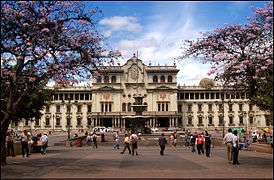Italian Guatemalan
| Total population | |
|---|---|
| (4.071 italian residents in Guatemala (2009/31/12) [1] and an unknown number of Guatemalans of Italian descent) | |
| Regions with significant populations | |
| Guatemala city, Quetzaltenango and Zacapa | |
| Languages | |
| Spanish, Italian | |
| Religion | |
| Roman Catholicism and Protestantism | |
| Related ethnic groups | |
| Italians, Guatemalans |
Italian Guatemalans are Guatemalans of Italian ancestry. The Italians contributed in the construction of the country as monuments, parks and besides contributing at the National Conservatory.
History
The Italian immigration in Guatemala began in the early Republican era. One of the first Italians to come to Guatemala was Geronimo Mancinelli, an Italian coffee farmer who lives in San Marcos (Guatemala) in 1847.[2] However, the first wave of Italian immigrants came in 1873, under the government of Justo Rufino Barrios, these immigrants were mostly farmers attracted by the wealth of natural and spacious highlands of Guatemala. Most of them settled in Quetzaltenango and Guatemala City.[3]
Second and prosperous Italian colony

As the first Italian colony failure for lack of incentives. In early 1880, came another wave of Italian immigrants, within the government of Justo Rufino Barrios. This wave of immigrants was different from the previous one, since they arrived in this scientific, writers, painters, sculptors, musicians and wealthy families.[4]
By 1900, there were more than 1,000 Italians in Guatemala, sculptors Italians (under the government of Manuel Estrada Cabrera), built many historical buildings in Guatemala. This occurred in certain areas of Quetzaltenango, Zacapa and Guatemala City was inhabited mostly by Italians, which was a growth of Italo-Guatemalan children, Among these years, prosperity was in the Italian colonies of Quetzaltenango, Guatemala City and Zacapa, for the years 1930, Guatemala reached its maximum number of Italian residents, the second country in Central America, behind Costa Rica. And according to historian Vittorio Capelli, also there were important immigrations in Panama and Nicaragua and some immigrations in El Salvador and Honduras.[5]
The Italians were pioneers in bringing European technology in Guatemala (along with the Germans), the first driver throughout Guatemalan history was Dante Naninni, descendant of Italian drivers. He was also member of the Italian Air Force during The World War II. In the late 1890s, the first cars arrived in Guatemala were of Italian origin, besides the decades between 1870s and 1900s, the Italians built the railway (El Ferrocarril de los Altos).[4]
During this migration, the Italian influence came to the Guatemalan literature, mainly in the late nineteenth century, many indigenous literature of the colonial period was translated by Italian writers. Other writings of Italians in Guatemala reflected the natural and tropical beauty of the country. The Italian editors Aliprandi and Martini painted a vivid picture of the Guatemala's Italian community in 1932.[6]
By mid-1930, Italian immigrants were the second largest immigrant group in Guatemala after the Germans, however, unlike the Germans, the Italians never exceeded 10,000 immigrants in Guatemala, and the growing Nazi influence in Guatemala by the Germans,[7] this rest importance to the Italian community by the government, which the prosperity of this colony came to an end.
Notable Italian-Guatemalans
- Stefano Cincotta, is a Guatemalan footballer who plays for Germany.
- Juan Jose Gerardi Conedera, was a Guatemalan Roman Catholic bishop and human rights defender.
- Marco Pappa, is a Guatemalan footballer who plays for the MLS club Seattle Sounders FC. He is a member of the Guatemala national team.
- Dwight Pezzarossi, is a retired professional football forward who last played for Comunicaciones in the Liga Nacional de Guatemala.
- Dante Naninni, the first Guatemalan pilot.
- Ricardo Bressani, scientist inventor of the incaparina.
- Alaíde Foppa, women poet, writer, feminist, art critic, teacher and translator.
- Rodolfo Galeoti Torres, sculptor
Architecture


A number of Italian architects arrived in Guatemala towards the end of the 19th century, giving rise to an Italian-influenced art and architectural movement, particularly in the capital, and several Italian architects oversaw construction projects in Quetzaltenango; these included the Templo de Logia Fénix No. 2, by Alberto Porta.[8] A group of Italian architects, including Porta and Luigi Lutti, with sculptor Desiderio Scotti, founded the Academy of Municipal Architecture, and were responsible for building many of the most prominent buildings in Quetzaltenango, including the Banco del Occidente and Pasaje Enríquez.[9]
See also
References
- ↑ Departamento del Interior y Ordenación del Territorio de Italia. "Annuario Statistico 2009" (PDF) (in Italian). pp. 121–129. Retrieved 2009-11-24.
- ↑ Wagner, Regina (November 2001). Historia del café de Guatemala. Bogota, D,C, Colombia: Anacafe. pp. 203, 207. ISBN 958-96982-8-X. Retrieved 2014-10-27.
- ↑ Los múltiples rostros de la diversidad p.61. Informe Nacional de Desarrollo Humano, Guatemala 2005.
- 1 2 italiana La ciudad es como tú, cumple. Cultura
- ↑ Cappelli, Vittorio. Nelle altre Americhe. Calabresi in Colombia, Panamà, Costa Rica e Guatemala. La Mongolfiera. Doria di Cassano Jonio, 2004.
- ↑ L’emigrazione italiana in Guatemala attraverso la letteratura University of Milan. By Patrizia Spinato Bruschi
- ↑ La cara europea de Guatemala March 9, 2010.
- ↑ "Quetzaltenango en la historia" (in Spanish). Quetzaltenango, Guatemala: Municipalidad de Quetzaltenango. Archived from the original on 2015-01-23. Retrieved 2015-04-20.
- ↑ Liano, Dante (2003). "Introduzione". Dizionario biografico degli Italiani in Centroamerica (in Italian). Milan, Italy: Vita e Pensiero. pp. xv–xvi. ISBN 9788834309797.